Pensions Lecture Notes
1/46
Earn XP
Description and Tags
Flashcards focusing on key terms and concepts related to pensions and their economic implications.
Name | Mastery | Learn | Test | Matching | Spaced |
|---|
No study sessions yet.
47 Terms
Transfers
Support or benefits provided from one group to another, such as resources from the rich to the poor through the tax system.
Pensions
Regular payments made to retired individuals, funded through private contributions or public tax revenues.
Pay-As-You-Go (PAYG)/unfunded
A method of pension funding where current workers' contributions fund current retirees' benefits, paid out of current tax revenues
basic idea, e.g in uk £180 a week that people get from state pensions, paid by taxes
if youre a pensioner with a good high pension, you alsop pay taxes which contoirbute towards this
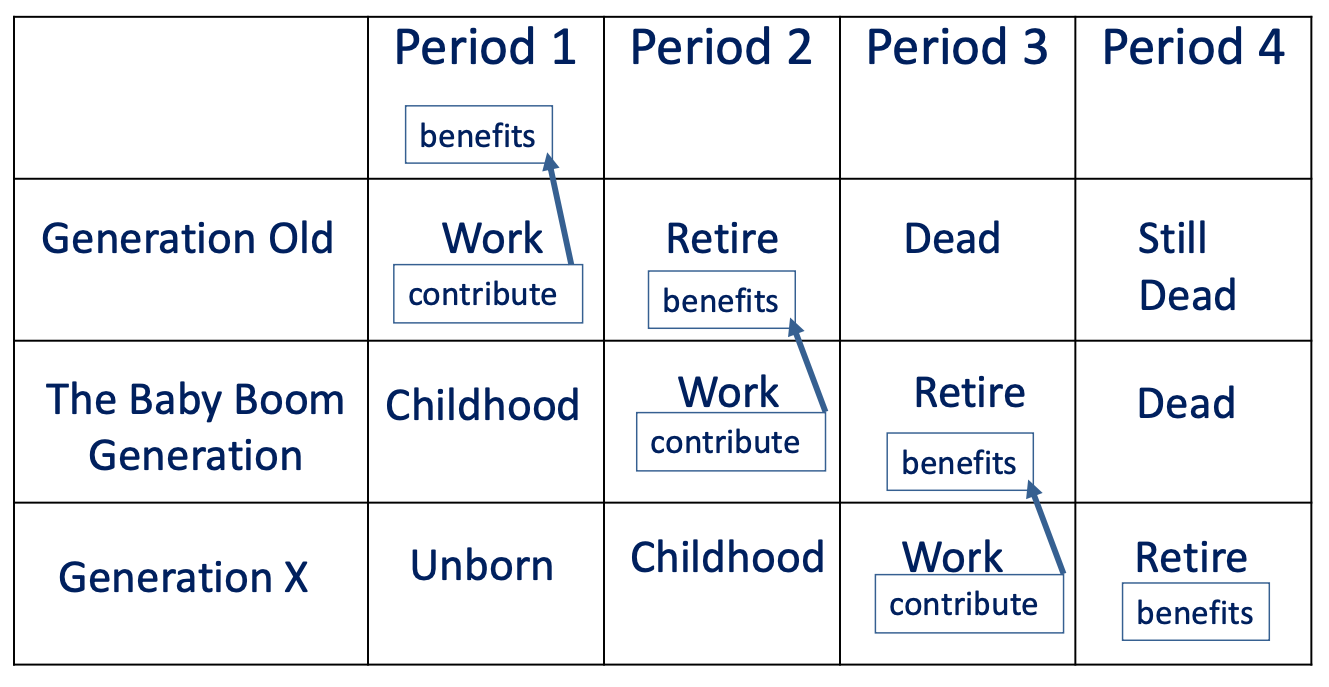
Funded pensions
Pensions that are paid out of an accumulated
fund, typically managed through investment funds.
in a fully funded plan theres no dependence on others, everyone funds themself
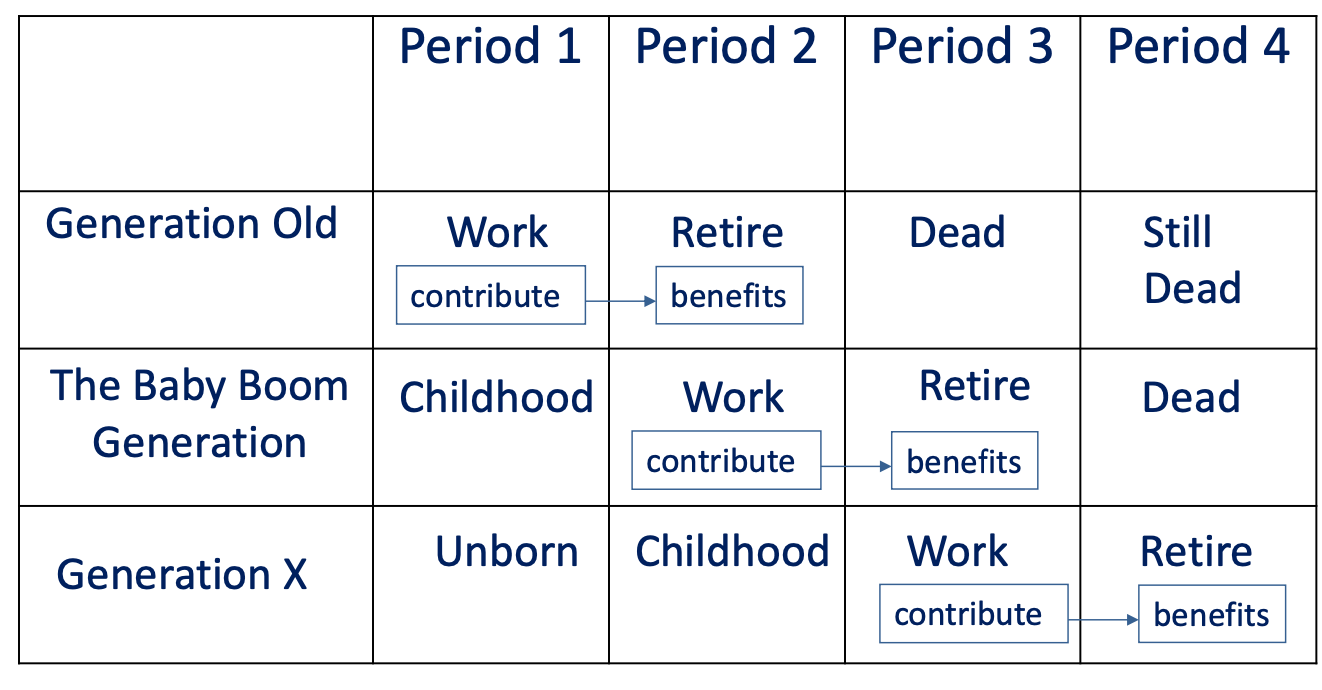
Intergenerational redistribution
The transfer of income or resources across different age groups, typically from the working population to retirees.
Crowding out
A situation where government spending leads to a decrease in private sector investment or savings.
Wealth Substitution Effect
The change in saving behavior induced by the existence of social security benefits, often leading to decreased personal savings.
purpose of private pensions
consumption smoothing: you save income in the good times for the worse times like when youre sick
a rational person should prefer to invest in a pension
insurance: youre insuring yourself to have a nice old age
e.g if you knew youd die at 65 no ppint in having a pnesion
private pensions as annuity
if you build up your annuity and then die the day after, your money can be used to help others
shown as discounting value
A is the present value of the pension stream y for the rest of life (assume 0 inflation)

annuities
person exchanges lump sum for annual payment of income for life (defined benefit or defined contribution)
its a form of insurance, since individuals pool the risk of dying younger or older
those who fail to achieve life expectancy subsidise those who live longer than expected
because people dont know how long thye’ll live for, risk pooling can improve individual welfare
adverse selection could be a slight problem, but not really
defined benefit
what you want, but none of us will get
this means the risk is on the employer, and youre paid an agreed amount - u have no risk
defined contribution
most pension schemes are like this. private sector firms, life expectancy has shot up and many people are retiring, so beneift schemes have become unaffordbale
means whatever is in your annuity will be determined on the day by the stock market - all the risk if on you
e.g if the stock market crashed on the day, tough luck
supply side sources of market failure that night lead to the gov wanting to get involved
incomplete insurance
annuities, is life expectancy a risk or an uncertainty, can be hard to insurance companies to set premiums
unanticipated inflation destroys pensions, so government might have to step in and top up pensions
demand side sources of market failure that night lead to the gov wanting to get involved
information and behavioural problems
we want to make sure eveyone has in income when they retire, but want to ensure they spend it on pensions - paternalisitc argument
theres costs of choice, info and behavioural problems
rationale for state involvement
market failure combined with paternalistic concern for poverty/equity mean that Govs become involved in pension provision
degree of involvement open to debate
advantages of PAYG schemes
cope well with inflation, if it occurs then pensions go up bc wages go up
incentivises generations to leave good economci conditons, becayse the ones that come after them have to work and payv taxes to fudn their pensions
allows full pension to be paid immediately
vertically equitbale, the people who pay the most are the rich but the people who get the most are the poorer ones
problems with PAYG schemes
disincentives to save and work, if you know you have the pension coming up, it might affect your incetives to save - you may put more money into a funded scheme if you had to provide for yourself, but you dont
does this lack of saving have an affect of economic growth
maybe you retire earlier if you think u have enough to last you until your state pension comes in
sensitive to blips in birth rate, but so are funded schemes
if you have a large cohort of pensioners relative to workers like we do now, implies taxes go up or benefit go down
not a very strong argument
first tier pensions
aimed primarily at poverty relief
state pension, main aim is so everyone can live
can be contributory or non contributory
non contributory means everyone gets the same, contirbutory means you can add more
second tier pensions
Intended to strengthen consumption smoothing
Mandatory, public or private
can insist you have to have a pension, can use the you have to opt out instead of opt in
May be combined with first tier
e.,g NEST in UK
third tier pensions
Intended to allow for differences in preferences
Voluntary
can be organised by industry, firm or individual
pensions in the UK
PAYG
established 1948
retirement age for women: 60
retirement age for men: 65
planned to rise to 68
pensions in the US
almost all workers in US pay FICA tax on earnings
person must have worked and paid tax for 40 quarters (10 years) over their life and must be over 62
retiring at 62 gets u a smaller pension, normally those with good private pensions retire this early
social security
A federal program that taxes workers to provide income support to the elderly PAYG
how are social security benefits calculated
The amount of this annuity payment is a function of the recipients average earnings over the persons 35 highest earning years where each months earnings expressed in todays dollars
replacement rate
ratio of benefits received to earnings prior to the entitling event
intergenerational redistribution equations
Nb = number of pensjoners x B, the beenfit
tax x number of workrs x average wage w
increasing in taxes, number of workers and economcu growth, captured by wage increases
divided by number of pensioners
recently nw, nb has been increasing, w is flatlining and this is creating a lot of strain
So growing population and wage growth increase benefits for fixed taxes
so retired generations share in growth
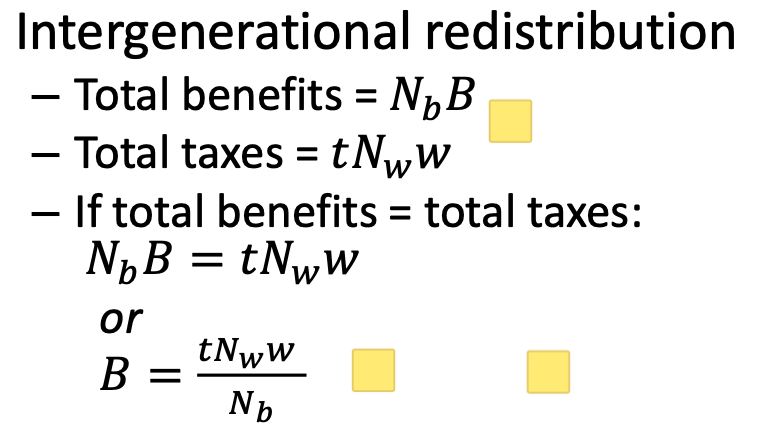
budget constraint for present and future consumption
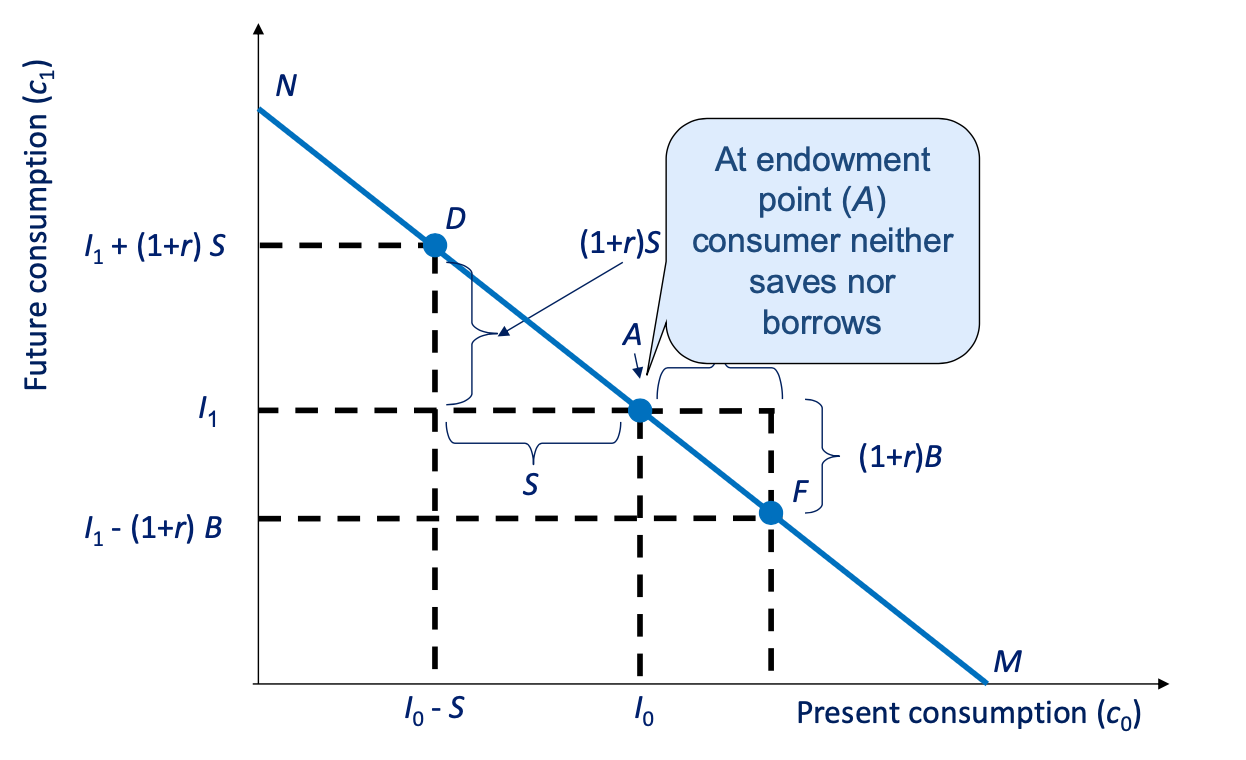
utility maximising choice of present and future consumption
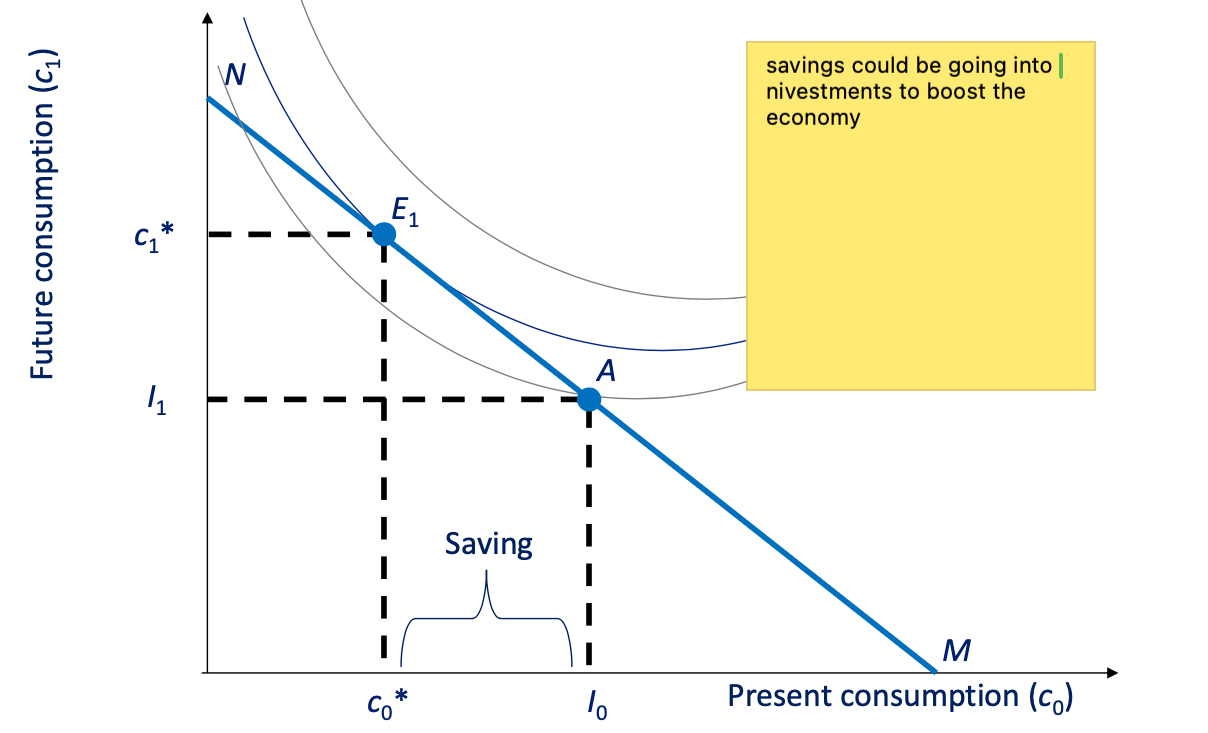
crowding out of private saving due to social security (wealth sub effect diagram)
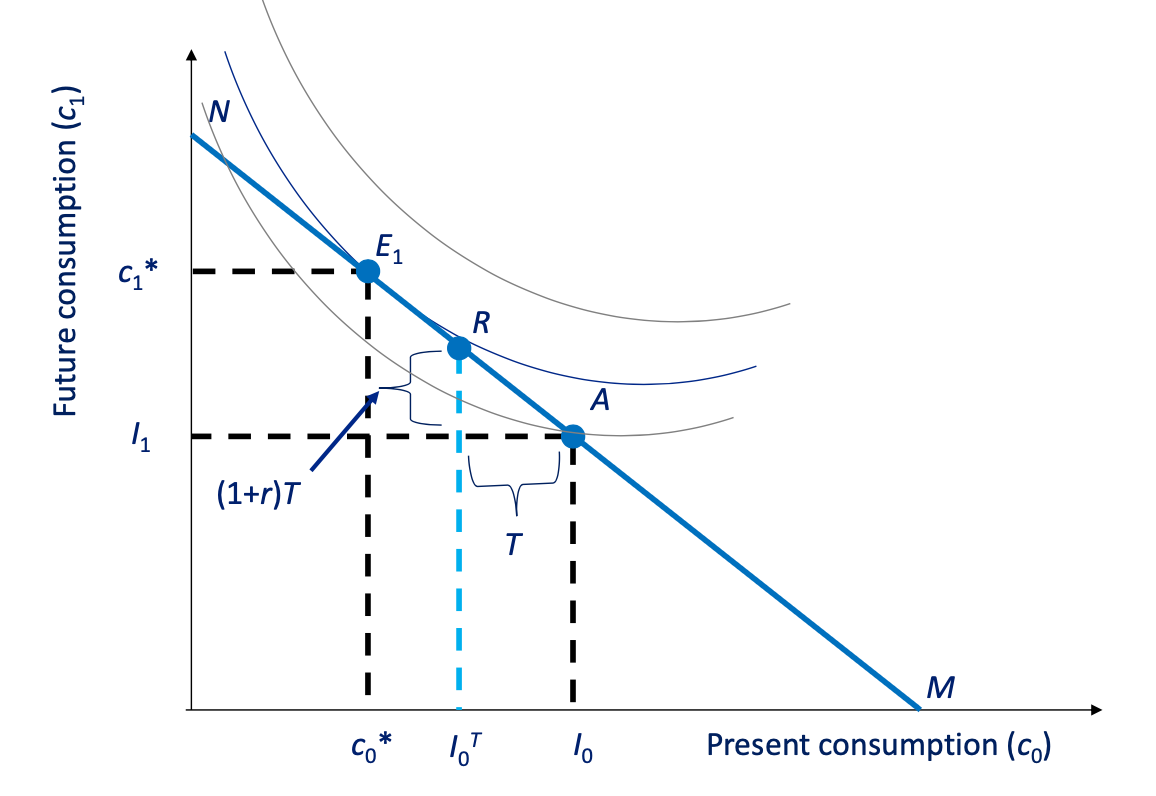
3 ways social securtiy can affect savings
Wealth Substitution Effect
Retirement Effect
Retire early (increase savings in anticipation)
Bequest Effect
Save more to offset effect of social security
payments on children
does social security consumption smooth
social security may crowd out savings that individuals would’ve set aside of retirement
might crowd out private savings by allowing people to count on gov transfer to support old age income
the larger the crowd out, the less consumption smoothing it provides for retired individuals
alternative: means testing pensions
- adminsitrativly this is rellay dificult, becayse youre measuring assets
- if youre well off, you dont need a state pension
- but lower middle class may vastly reduce their savings and get the state pension
- so this could affect savings badly
- unviersal benefits are easier and better politically, because the middle class will want you to favour them
effect of social security on consumption smoothing
can be seen in elderly poverty rates
he steepest reductions in poverty occurred during the
1960s and 1970s, when the program grew the fastest.
the point of pensions is to alleovate poverty, but study by Gallani et al. (2016) of a cash transfer in Mexico finds that theres no crowding out - if youre poor and you get extar money, you increase your consunption
social security wealth and retirement decision
Weigh up cost of delay (tax and forgone benefits) vs benefit of above average earnings and higher benefits due to delay
evidence: age at which pension is first available is important
implicit social security taxes
across countries, lots of variant in implicit tax rate
close to 0 for 62 year olds in US
91% in netherlands
countries with higher taxes have less elderly labour force participation
evidence that potentially very costly to design Social Security systems that penalize additional work beyond the retirement age.
Adjusting systems to more fairly reward work at old ages can mitigate much of the moral hazard effect of Social Security.
pensions and economic growth
Three links in the argument
Does funding increase saving?
is that saving translates into efficient investment
By how much does that investment increase output?
need to test each link
long term stresses on pensions
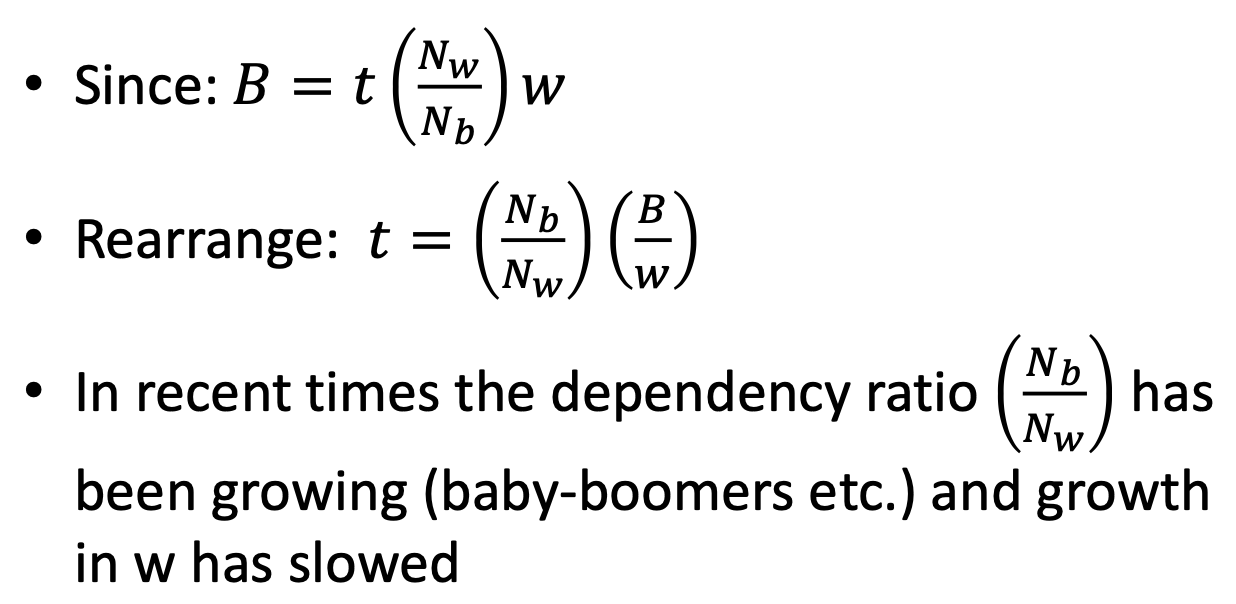
funding savings and growth
life expectancy is increasing in most counties while birth rates are falling
this can create issues off pension finance, but funding is only part pf the solution
what matters moree is size of the cake
static output: effects of demographic change on funded pensions
financial asset accumulation, desires asset sales by pensioners exceeds desired purchases by workers
excess supply in asset market reduces asset prices
this reduces pension accumulation and hence value of annuity
similar to PAYG issue
growing output: effects of demographic change on funded pensions
Asset accumulation: wages generally keep pace with output.
rising wages imply rising demand for assets, hence no effect on asset prices
period 2 pensioners get the real pension they expect
key question: whether funded pensions are more likely
to generate growing output than PAYG
transitional costs of changing pension
there will be double taxation of generation paying PAYG but told they must fund their
own pension (us)
Political economy aspects: Funding and property rights
Are funded pensions safer from government
interference than PAYG pensions?
Does full funding impose greater financial
discipline?
Is greater discipline optimal? Is the ability to
change future benefits simply a source of risk
to workers and retirees, or an opportunity to
do a better job of sharing the risks inherent in
pension systems
2 strategies of raising output
Increasing the productivity of each worker, through
(1) more and better capital equipment
(2) more productive labour
Increasing the number of workers from each age
cohort
(3) increased labour force participation
(4) increased age of retirement
(5) import labour directly (immigration)
(6) import labour indirectly (export capital)
to what extent is funding a solution
In the face of demographic problems the key
variable is output
From a macroeconomic perspective the choice
between PAYG and funding is secondary
how should pensions be financed
can address issue of pension finance by:
Increase output
• Reduce the living standards of workers by
increasing pension contributions
• Reduce living standards of pensioners
• By paying a lower pension
• By increasing the age at which pension is first paid, i.e.
reducing the duration of retirement
summary: arguments for increased use of funded pensions rest on":
increased growth bc such. move would necessarily trade off with equity consdierairtons
Intergenerational redistribution
Redistribution from rich to poor
Redistribution from men to women
UK triple lock pensions
A policy ensuring that UK state pensions increase each year by the highest of inflation, average wage growth, or 2.5%, aimed at protecting pensioners' living standards.
paul jonson says if this continues then pensions will become very geneorus in the future
Is this too generous.
Is this because pensioners are politically too
powerful?